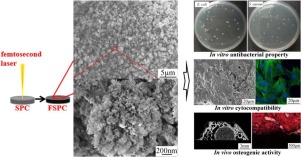Applied Materials Today ( IF 7.2 ) Pub Date : 2019-12-13 , DOI: 10.1016/j.apmt.2019.100523 Han Wu , Tao Liu , Zhiyan Xu , Jun Qian , Xuening Shen , Yuan Li , Yongkang Pan , Deqiang Wang , Kai Zheng , Aldo R. Boccaccini , Jie Wei

|
Poor cell adhesion and osteogenic activity impede the bone regeneration and osseointegration effects of polyetherketoneketone (PEKK) implants. Surface modification and incorporation of bioactive fillers are effective strategies to promote the cellular responses of PEKK implants and their integration with bone tissues. In this study, silicon nitride (SN) microparticles were blended with PEKK to develop bioactive composite implants (SPC). Femtosecond laser was then used to modify SPC surfaces inducing favorable micro/nano structural surface (FSPC). After the laser ablation, irregularly shaped SN microparticles were converted to “petal-like” clusters composed of “pin-like” SN nanoparticles, while the entire surface was covered by SN particles due to the removal of PEKK. The roughness, hydrophilicity, content of surface chemical groups (e.g., -NH2), and protein adsorption capability of FSPC were significantly enhanced compared to SPC and PEKK. Also, the release of biologically active Si ions was increased after the femtosecond laser treatment, inducing a positive microenvironment favorable for cellular activities. Moreover, FSPC exhibited a greater bacteriostatic activity against Escherichia coli (E. coli) and Staphylococcus aureus (S. aureus) than SPC. The presence of micro/nano structure also remarkably promoted adhesion, proliferation, and osteogenic differentiation of rat bone mesenchymal stem cells (rBMSCs). In vivo evaluation of the composites in a rabbit femur defect model verified that FSPC could enhance osteogenesis and osseointegration to a greater extent than SPC, evidenced with greater bone-implant contacts and push-out force. These results indicate that the femtosecond laser induced micro/nano structural surface on SN/PEKK implants can significantly promote osseointegration and bone repair. The femtosecond laser exhibits great potential in surface modifying bioceramic/polymer composites. The fabricated FSPC have shown great potential as bone implants in orthopedic applications considering their excellent biocompatibility, bacteriostatic property, osteogenic activity, and osseointegration.
中文翻译:

飞秒激光诱导的微/纳米结构表面增强氮化硅/聚醚酮酮复合材料的抑菌活性,成骨作用和骨整合
不良的细胞粘附和成骨活性阻碍了聚醚酮酮(PEKK)植入物的骨再生和骨整合作用。表面改性和生物活性填料的掺入是促进PEKK植入物的细胞反应及其与骨组织整合的有效策略。在这项研究中,将氮化硅(SN)微粒与PEKK混合在一起以开发生物活性复合材料植入物(SPC)。飞秒激光然后用于修饰SPC表面,从而产生有利的微/纳米结构表面(FSPC)。激光烧蚀之后,不规则形状的SN微粒被转换为由“针状” SN纳米颗粒组成的“花瓣状”簇,而由于去除了PEKK,整个表面被SN颗粒覆盖。表面化学基团的粗糙度,亲水性,含量(与SPC和PEKK相比,FSPC的蛋白质吸附能力(例如-NH 2)显着提高。此外,飞秒激光处理后增加了生物活性硅离子的释放,从而诱导了有利于细胞活动的积极的微环境。而且,与SPC相比,FSPC对大肠杆菌(E.coli)和金黄色葡萄球菌(S.aureus)具有更大的抑菌活性。微/纳米结构的存在还显着促进了大鼠骨间充质干细胞(rBMSC)的粘附,增殖和成骨分化。体内兔股骨缺损模型中复合材料的评估证实,与SPC相比,FSPC可以更大程度地增强成骨和骨整合,并显示出更大的骨-植入物接触和顶出力。这些结果表明,飞秒激光诱导的SN / PEKK植入物上的微/纳米结构表面可以显着促进骨整合和骨修复。飞秒激光在生物陶瓷/聚合物复合材料的表面改性方面具有巨大潜力。考虑到其出色的生物相容性,抑菌性能,成骨活性和骨整合性,制成的FSPC在骨科应用中已显示出巨大的潜力,可作为骨植入物。











































 京公网安备 11010802027423号
京公网安备 11010802027423号